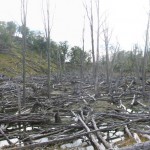
Source. Scientific American. Reported by Katie Worth. See slideshow.
Argentina and Chile Decide Not to Leave it to Beavers.
Importing the incisor-toothed hydrologists from Canada to the southernmost tip of South America seemed like a good idea in 1946, but it wasn’t.
Rarely has the inception of an environmental disaster been so triumphantly documented.
In a recently unearthed black-and-white newsreel, which played before movies in theaters across Argentina in 1946, a newscaster reported that 20 beavers have been trapped in Canada and flown to Tierra del Fuego—the island that straddles the border between Argentina and Chile at the southernmost tip of South America. Argentine Pres. Juan Perón’s administration had imported the animals in hopes that they would thrive and reproduce, fostering a fur trade in the economically lackluster territory. “The beavers, who eat branches of trees and bark, will find abundance here,” the newscaster stated, as the camera pans across kilometers of virgin Fuegian forests. The beavers, released from their cages, slip into a river as the voice added gravitas to the dam-building beasties’ entry into their new environs, “Now they are in God’s hands.”
Abundance they found. Six decades later the descendants of those 20 pioneers number in the tens of thousands in Patagonia. The beasts have swum from Tierra del Fuego to the continent and beyond, and now occupy an unknown number of islands in the vast uninhabited archipelago off the coast of southern Chile. As they waddle their way north, building dams, creating ponds and procreating, they lay waste to vast tracts of land, which appear scorched or bulldozed. The destructive power of the beavers in Patagonia surprised ecologists in North America, where the same animals have been reintroduced to wetlands in need of restoration. Read more by clicking here.
